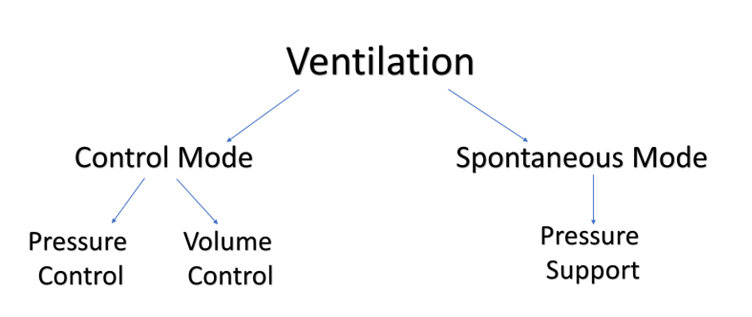2.8 Basic Ventilation Modes. The Ventilation “Family Tree”
Unless specified otherwise, in this chapter, ventilation modes will refer to modes used with invasive mechanical ventilation. A ventilation mode is a set of predetermined rules, that the ventilator follows to provide or support ventilation. If you imagine ventilation like a family tree, control and spontaneous are the main branches. Up to this point, we discussed the classification of ventilation modes based on the type of breath delivered: controlled, assisted or spontaneous. We also know that the timing of the breath delivery also makes a difference in the classification of ventilation modes. Mandatory breaths are delivered at a certain rate in continuous mandatory ventilation (CMV). Patients will take spontaneous breaths in continuous spontaneous ventilation (CSV). A third option is available as intermittent mandatory ventilation (IMV) or Synchronized Intermittent Mandatory Ventilation (SIMV), which allow controlled (mandatory) breaths, assisted breaths and spontaneous breaths, based on patients needs. This is only part of the story. For complete description of a ventilation mode, the control variable must be included.
Control modes are further split into two main sub-categories:
- Volume Control— the ventilator will deliver a set volume of air to the lungs
- Pressure Control—the ventilator will deliver a set pressure of air to the lungs

Irrespective of the labelling or description of control breaths, it is important to remember that they are predetermined and delivered by the ventilator. Both categories lead to the same outcome, which is a fully “controlled” breath that the patient will receive. Essentially, every controlled or mandatory breath, whether labelled as volume or pressure breath, refers to the same process of the ventilator pushing air into the lungs. The terms “pressure” or “volume” simply describe the settings on the ventilator. Both pressure and volume modes accomplish the same objective of delivering air into the lungs based on the clinician’s selected settings and allowing passive exhalation. The distinction lies in the parameter being controlled during each breath
For a patient with intact drive to breathe, taking spontaneous breaths, most commonly, breaths are delivered via pressure support ventilation.
Key Takeaway
“The Ventilation ‘Family Tree'” from Basic Principles of Mechanical Ventilation by Melody Bishop, © Sault College is licensed under a Creative Commons Attribution-NonCommercial-ShareAlike 4.0 International License, except where otherwise noted.

